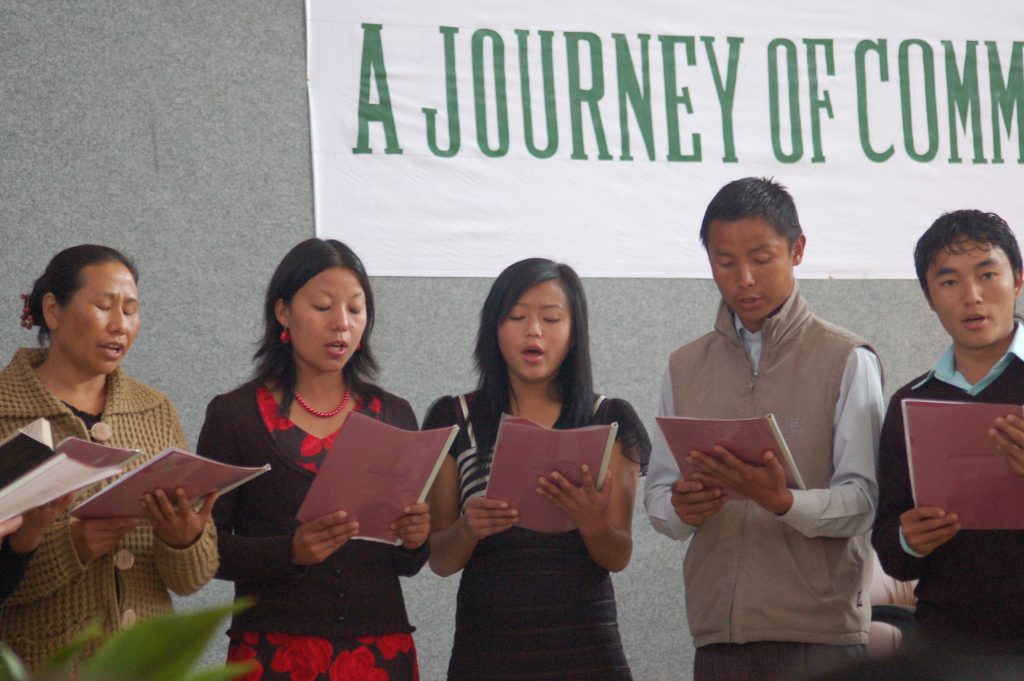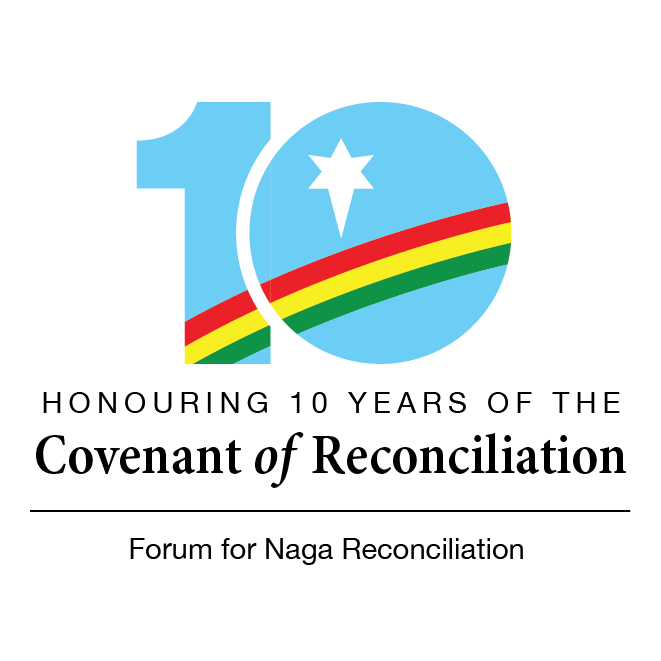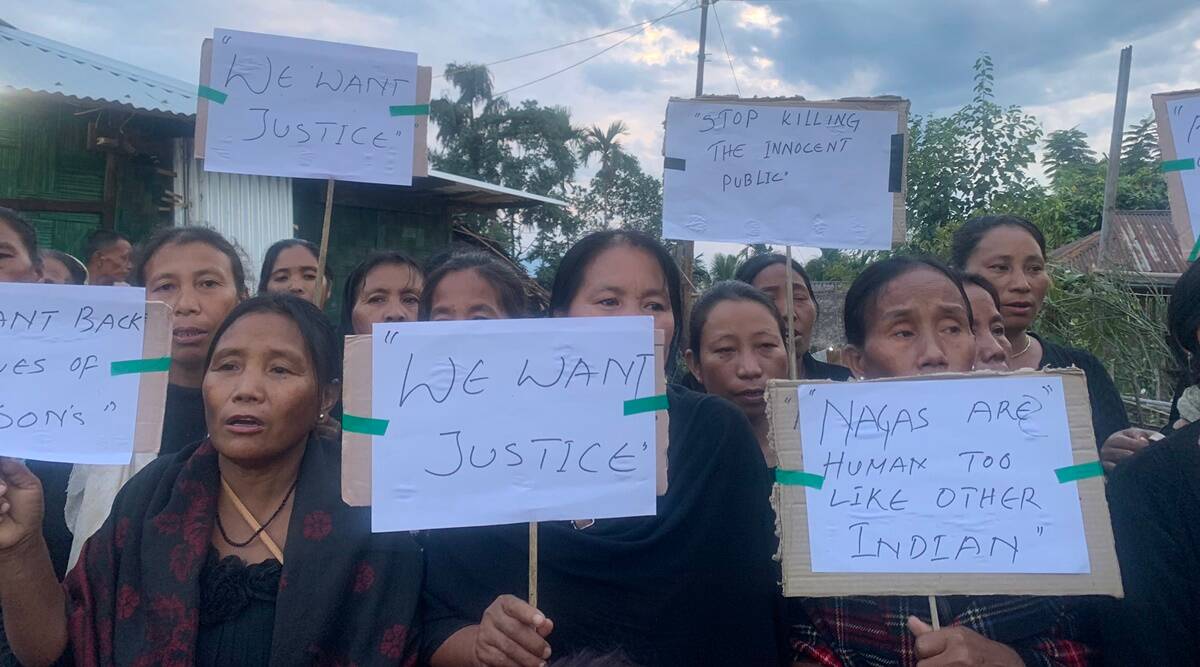By Daniel Buttry*
Who is it that shapes history, particularly at this point in the human story? Is it the political and military leaders? Is it the Presidents, Prime Ministers, Generals, Revolutionaries, and other such folks? Is it the people with weapons in their hands or armies to command? Yes, sometimes. At least these are the ones our history books and the media focus on.

A New Song: Music has been integral to the Naga Reconciliation process. Here young people are seen singing a song of healing and reconciliation during at Naga public meeting with the Joint Working Group of the NPGs and FNR at Zunheboto (February 2010).
But there are other shapers of history who often get less attention, namely, the people without the weapons. Whereas the guys with the guns (mostly men) get most of the attention, more and more it is the people without the guns who are leading humanity toward a more positive destiny. India saw this with the leadership of Mahatma Gandhi and Abdul Gaffar Khan in the struggle against British colonial rule. More recently the Nagas have seen this dynamic of unarmed People Power in their own struggle for identity, freedom, peace, and hope.
All around the world in a wide variety of cultural and political contexts movements of people demanding change through nonviolent means have proven to be the most effective way to advance their cause. Not all of them succeed, but not all armed struggles succeed either. Erica Chenoweth in her landmark book Why Civil Resistance Works: The Strategic Logic of Nonviolent Conflict, through studies of every conflict around the world she could find from 1900 to 2006, has shown that nonviolent movements have been twice as effective as violent movements in reaching their political goals.
So how has Naga history played out? An initial nonviolent struggle in the Gandhian model failed to bring Naga independence after the 1947 declaration of independence and the 1951 plebiscite. Violence erupted at horrific levels between the Indian army and Naga forces. Eventually following a failed peace process the Naga political groups split into factions and still more factions. Each faction claimed to represent the Naga cause, but they killed as many Nagas in the struggle as were being killed by the Indian Army. This struggle lasted for decades with no acceptable end in sight.
Then Naga people without guns took their destiny into their own hands. A number of Naga leaders from church, human rights, business and other backgrounds began to organize for talks among the Naga factions for reconciliation, as well as push for a cease-fire with the Indian forces. The Atlanta Talks were held in 1997 with large demonstrations of support back in Nagaland. Those talks failed to bring all four of the Naga factions together at that time. However, they did set forth the goal of Naga reconciliation and a process driven by the broad desire of the Naga people to cease the factional fighting that was leaving so many Nagas dead and communities devastated.
Then followed the massive gathering of the Naga Baptists to celebrate the 125th Anniversary of the Christian Gospel coming to the Naga people. In a public setting the desire for peace expressed by the people in mass prayer turned a formal 4-day cease-fire among the factions into an informal cease-fire that lasted for years. The Naga people had let their desire be made known in a powerful, passionate and public way, and the groups claiming to represent those people had to respond if their claims of being their rightful leaders were to have any integrity.
Talks between the factions and the Government of India dragged on without any progress. The inter-factional reconciliation was going nowhere, so in 2000 the Naga civil society groups again gathered to strategize and rethink their approach. The idea was conceived of the Journey of Conscience, inspired by Gandhi’s Salt March and the Freedom Rides of the U.S. Civil Rights Movement. The idea was to take a publicized journey from Nagaland to Delhi, to speak from the heart of the Nagas to the heart of India. In Delhi three days of special events took place: A visit to and service at Gandhi’s tomb, a consultation with Indian civil society groups about the Naga situation, and a public demonstration for peace and justice related to the Nagas.
That Journey of Conscience took place in January 2001, and it accomplished more positive impact than years of violent struggle by the Naga political factions. Awareness of the Naga situation and a more positive view about it grew, not just in India, but globally as the Journey of Conscience travelled beyond India’s borders. Unarmed people were proving to be more effective in getting Naga concerns before the world than those with the guns.
The problem that developed, however, was that those with the guns were doing the negotiation about what a political solution would look like. Some were at the table, but others were not. Furthermore, the talks went nowhere. Though the Naga civil society had brought the Naga cause more attention than ever, the people on all sides who controlled the decision-making, namely the GOI and Naga factions, were not making progress. Peace seemed to be stalled once again. Yet, except for occasional incidents, Nagas weren’t being killed either by the Indian Army or by their Naga brothers in the various factions.
Once again it was people armed, not with guns, but with the Spirit of God, personal courage, and creativity who stepped forward to shape Naga destiny. Conceived in a prayer meeting the Chiang Mai process was born, a series of meetings in Chiang Mai, Thailand, involving all the major Naga political factions. This process was convened by the new Forum for Naga Reconciliation (FNR), an organization of Naga church leaders, women’s leaders, student leaders, human rights leaders, and others. The FNR worked in partnership with international peacemakers, especially British Quakers and U.S. Baptists from the American Baptist Churches and the Baptist Peace Fellowship of North America.
Through a series of meetings various steps were taken on the road to reconciliation, culminating in the signing of the Covenant of Reconciliation by S.S. Khaplang, Isak Swu, and Brig. Singnya in 2009. This Covenant was the result of leaders from across the broad spectrum of Naga society, including leaders from the Naga Baptist churches, lifting up reconciliation. If the phrase “Nagaland for Christ” is to have any meaning how can reconciliation not be a high priority? The Naga political leaders deserve credit for embracing this call, but the Naga people deserve credit for making the call to reconciliation an expression of their agenda.
Ten years have passed. Some signatories of that original Covenant of Reconciliation have passed on. But the call to reconciliation stands firm. The commitment to find the way forward also stands. More divisions have taken place, political arguments have been made, but the people’s agenda has not faded in both its necessity and urgency. So whatever political stands are taken those leaders must give serious attention and credence to the commitments enshrined in the Covenant of Reconciliation. This was not a document put together under pressure by the Government of India without the involvement of key Naga leaders as happened with the Shillong Accord. This was a document compelled by the Naga civil society and signed by the top leaders from the major Naga political factions. The Naga people have spoken and Naga leaders recognized and responded to that agenda.
But Nagas know the journey of the spirit can start with good intentions. People commit themselves for Christ, then soon they stumble and fall back into their old ways. There is an opportunity to repent, to turn around, to make a 180° turn. The clear standard of the Covenant of Reconciliation may be 10 years, old but is still relevant today. It expressed the will of the Naga people clearly, so it is up to both the Naga political leaders and the Naga people as a whole to recommit themselves to the practical steps of making the dream expressed in that covenant a reality.
Nagas love to recite history, citing the years and milestones of the Naga struggle. The reason I’ve gone through this recitation of more recent history is to show that the leadership for Nagas hasn’t come from the top down but from the bottom up. While top leaders have claimed to represent the Naga people, the Naga people have been making it clear that they want peace and reconciliation. Anybody who splits the Nagas into Naga versus Naga factionalism and violence has not given proper expression to Naga desires. Whatever claims may be made from the top of such organizations, ordinary people have been asserting their demand for reconciliation in a way to which those political leaders have been forced to respond. Political statements have shifted to try to show how each group is acting on those demands, even if they continue to actually be engaging in factionalism rather than taking the specific practical steps toward reconciliation.
The people without the guns are now driving the discourse and setting the agenda, and that is bringing hope for a better and brighter future for the Nagas as well as all their neighbors.
About the author:
*Daniel Buttry is the Global Consultant for Peace and Justice with International Ministries of the American Baptist Churches. He has worked with Naga groups and the reconciliation process since 1996.








 The Top Viral YouTube Videos of 2017
The Top Viral YouTube Videos of 2017 What Does Your Face Say About Your Health?
What Does Your Face Say About Your Health? An orbiting message of peace
An orbiting message of peace Meet R.N. Ravi, who is mediating peace with the Nagas
Meet R.N. Ravi, who is mediating peace with the Nagas










Leave a Reply
Your email address will not be published. Required fields are marked (required)